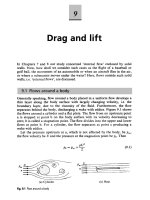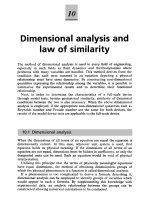Introduction to System Integration
Bạn đang xem bản rút gọn của tài liệu. Xem và tải ngay bản đầy đủ của tài liệu tại đây (154.7 KB, 22 trang )
System Integration
Mini Case Studies
© 2010
Introduction to System
Integration
Shawn A. Butler, Ph.D.
Senior Lecturer, Executive Education Program
Institute for Software Research
Carnegie Mellon University
Lecture Objectives
Understand what system integration
means for this course
Understand the motivations for integrating
systems
Be aware of some very important
heuristics
© 2010 CMU-ISR
2
System Engineers
Success comes from wisdom
Wisdom comes from experience
Experience comes from mistakes
© 2010 CMU-ISR
3
References
Ruh, William A. Maginnis, Francis X. Brown,
William J. “Enterprise Application Integration”,
Wiley Computer Publishing, 2001
Maier, Mark W. and Rechtin, Eberhardt “The Art of
Systems Architecting”, 2nd Ed. CRC Press, 2002
Cummins, Fred A. “Enterprise Integration”, OMG
Press, 2002
© 2010 CMU-ISR
4
What Does System Integration
Mean?
More than one application, module, or component
that…
Share data and…
Present user with consistent information
Examples:
• Travel systems that present the user with a
complete itinerary including travel, hotel, and
entertainment bookings
• Enterprise accounting and project management
systems
• Human resource and payroll systems
© 2010 CMU-ISR
5
Before You Begin …
Why are you integrating these
components/applications/systems?
What is the impact to the organization’s business
processes?
Are there proprietary or unique legacy systems
involved?
Has a different contractor already failed at this
task?
Who will benefit from the integration?
What is the benefit from the integration?
© 2010 CMU-ISR
6
Why are you integrating?
Adaptable systems and processes
Streamlined business processes
Management information
Support for electronic commerce
Integrated security
Replaceable components
Reliable and recoverable systems
Economies of scale
© 2010 CMU-ISR
7
Adaptable System and Processes
Systems and processes are tightly coupled
to computer applications
Process changes are difficult to support with
existing components
Application knowledge is lost
Changes are time consuming, costly, and
complex
Organizations want systems that are more flexible to change
© 2010 CMU-ISR
8
Adaptable Systems
Responsibility and control over each
business function is defined and assigned
Each business function is defined once,
performed in a consistent manner
Coupling and dependencies between
business functions are minimized
© 2010 CMU-ISR
9
Information Management
Data consistency
Data accessibility
Process consistency
Exception reporting
Historical data analysis
Just because we can share the data – should we?
© 2010 CMU-ISR
10
Support for Electronic
Commerce
Compatibility with the systems and applications of
customers and business partners
Mechanisms for timely and reliable
communication of information
Greater security risks
Data exchanged between your organization and
an external entity create issues of trust
New technologies facilitate electronic interchange
© 2010 CMU-ISR
11
Edited by Foxit Reader
Copyright(C) by Foxit Corporation,2005-2010
For Evaluation Only.
Integrated Security
Firewalls
Authentication
Authorization
Integrity
Confidentiality
Nonrepudiation
Security integration is much more difficult than you think!
© 2010 CMU-ISR
12
Replaceable Components
Historically, large proprietary systems could not
decouple components and functionality
Really difficult to reuse components
Also difficult to adapt systems to different
customers
Dependent on small number of vendors
Integration often created duplicate functionality
Trend is towards finer-grained, loosely coupled components
© 2010 CMU-ISR
13
Reliable System Operations
Minimize the risk that the system will fail
• A safe environment with reliable power
• Testing of equipment and software prior to
operation
• Solid change control processes
Detect malfunctions early
• Design and a solid testing program
Limit the impact of failure
• Redundancy
• Backup and recovery designed into the system
© 2010 CMU-ISR
14
Economies of Scale
An integrated system should cost less to operate
and adapt to changing needs
Duplication should be eliminated unless it
supports reliability
Complexity should be reduced
Economies are achieved through:
• Standards
• Software reuse
• Common infrastructure
• Consolidated systems operations
Standards alone in not sufficient to achieve the
benefits from system integration
© 2010 CMU-ISR
15
Technology Enablers
Middleware Technologies
Web Technologies
• User Interface
• Ubiquitous Access
XML
• Descriptive Tags
• Facilitates Transformation
Distributed Objects
• CORBA
• COM+
• Enterprise Java Beans
© 2010 CMU-ISR
16
The Value of Integration
Heuristics (Maier and Rechtin)
System engineers have only worked on a few
complex systems in their lifetime
System engineering does not yet have the rules
and formulas that form the foundation of other
engineering disciplines
Although they seem obvious, every systems
engineer will violate the heuristic at some time
during the design and development of their
system
© 2010 CMU-ISR
17
Heuristic 1
Don’t assume that the original statement of the
problem is necessarily the best, or even the right one.
© 2010 CMU-ISR
18
Heuristic 2
Build and maintain options as long as possible in the
design and implementation of complex systems.
You will need them.
© 2010 CMU-ISR
19
Heuristic 3
Simplify, Simplify, Simplify
© 2010 CMU-ISR
20
Heuristic 4
In partitioning, choose the elements so that they are as
independent as possible; that is, elements with low
external complexity and high internal complexity.
© 2010 CMU-ISR
21
Summary
Before you start thinking about integration, make
sure that the purpose is clear and feasible
Clearly understand the goals of the integration
Good systems engineers use heuristics to guide
them in design of a system
• Don’t assume that the customer knows exactly what they
want
• Keep the integration simple
• Keep your options open
• Keep components independent
© 2010 CMU-ISR
22









